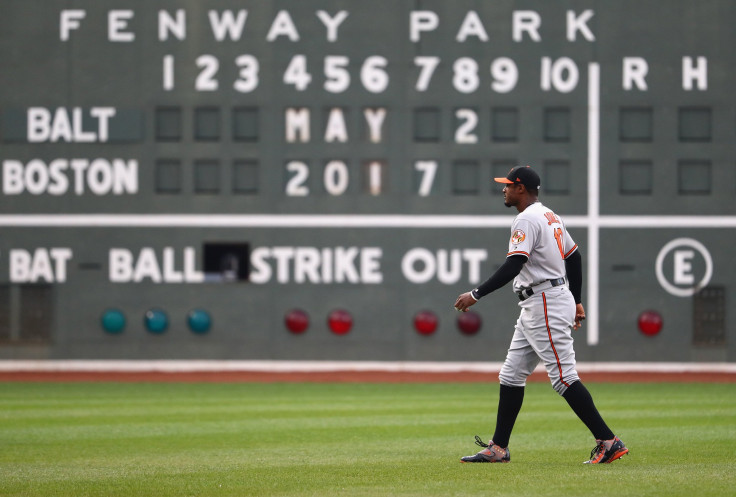Boston Had History Of Sports Racism Well Before Adam Jones Incident

The racial slurs directed at African-American Baltimore Orioles outfielder Adam Jones by Boston Red Sox fans at Fenway Park served as an unfortunate reminder of the city's lingering reputation for bigotry. The incident drew widespread condemnation, with even Massachusetts Gov. Charlie Baker posting on Twitter that fans' behavior was "unacceptable" and "shameful."
Jones, who joined the Orioles in 2008 and therefore has played dozens of games in Fenway, told USA Today reporter Bob Nightengale that he was "called the N-word a handful of times" during Monday's game and that a fan threw a bag of peanuts at him.
Some remorse and healing began Tuesday when fans at Fenway gave Jones an ovation in his first at-bat.
Read: Boston Red Sox Issue Formal Apology To Orioles' Adam Jones
On the MLB Network, play-by-play announcer Bob Costas pointed to "a sizable percentage of the Fenway fans coming to their feet to acknowledge Jones, not as a visiting player, but as a human being who should not have had to hear what he heard last night."
"Much appreciated. It was also much appreciated by the Boston Red Sox and MLB getting ahead of it," Jones said after the game about the reaction from the Red Sox. "Appreciative that action was taken, and that not everybody feels the same way as selected people."
The Red Sox went so far as to give the fan a lifetime ban from Fenway, though it wasn't the only racist incident that week. USA Today reported that a Red Sox fan had heard the N-word yelled by a middle-aged white man Tuesday after the national anthem was sung by a Kenyan.
Unfortunately, such racist incidents are nothing new. On Wednesday, an opinion piece by Boston Globe columnist Adrian Walker shed light on the city's "longstanding reputation for racism" and how Monday's incident "didn't come as a complete shock."
Many would agree with Walker that the racism extends well beyond the Jones incident.
"Boston has a reputation, partially left over from a long time ago, that there is more racism within Boston sports," Richard Lapchick, director of The Institute for Diversity and Ethics in Sport at the University of Central Florida, told the Associated Press. "The type of incident that happened ... is something I would’ve expected to read about in Boston 25 years ago."
There are deep roots of racism with the Red Sox. The Sox were the last team to call up a black player, waiting until 1959 for Pumpsie Green to debut. Star pitcher David Price, who joined the Boston in 2016, has said he heard racial taunts in his first season with the club while warming up in the bullpen.
In the 1960s, the Celtics were among the most integrated NBA teams with players like Bill Russell, Sam Jones, Satch Sanders, K.C. Jones, John Thompson and Willie Nauls. But decades later the roster seemed to consist of more white players than other teams. White players like Chris Corchiani, Todd Lichti and Matt Wenstrom were on the 1993-94 roster in limited roles and were out of the league the following year.
Current Celtic Jae Crowder recently said he felt “disrespected” when fans openly hoped for the free-agent signing of white player Gordon Hayward.
Avowed white nationalist Richard Spencer recently said that "it was like the alt-right won the Super Bowl," when the New England Patriots defeated the Atlanta Falcons in February.
In his column, Walker referenced Gosder Cherilus—a former member of the Indianapolis Colts who grew up in the Boston area—recalling a visit to Gillette Stadium in which he repeatedly heard the "N-word."
In a 2005 article in Boston magazine, longtime sports reporter Howard Bryant pointed out that the Boston Globe had employed just two full-time black sports columnists in its 133-year history.
Boston's racial problems aren't obviously confined to just sports. One of the city's biggest racial firestorms was set off in the 1970s, drawing national attention.
When a federal district court judge in 1974 ruled Boston had deliberately segregated public schools, it prompted roughly 18,000 black and white students to be bused to schools outside their neighborhoods and led to hundreds of white demonstrators pelting buses in South Boston. The Boston Busing Crisis continued to be far from peaceful, with police wearing riot gear as violence escalated and with the mayor having to declare a curfew.
© Copyright IBTimes 2025. All rights reserved.






















